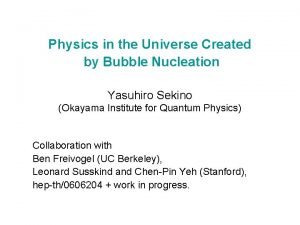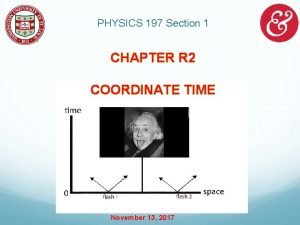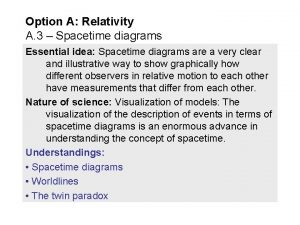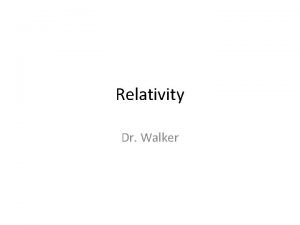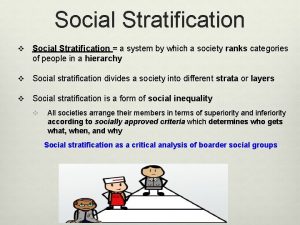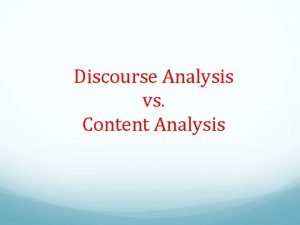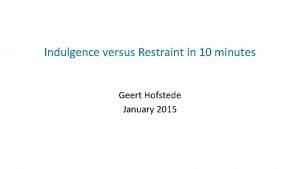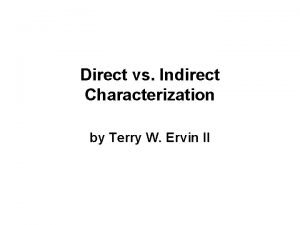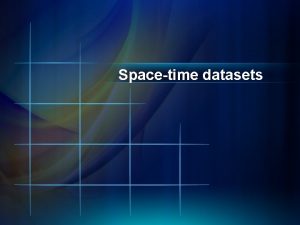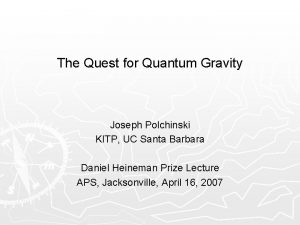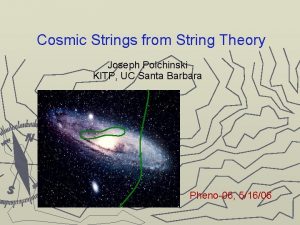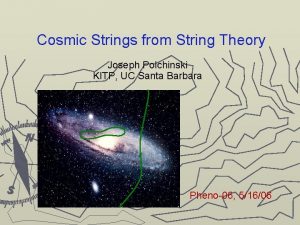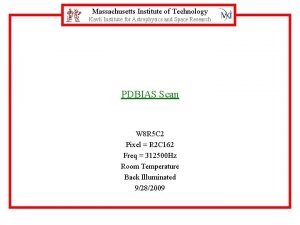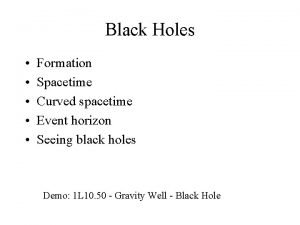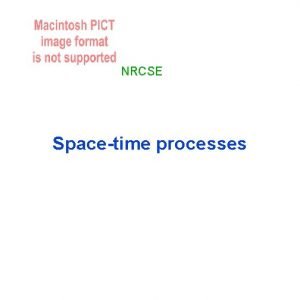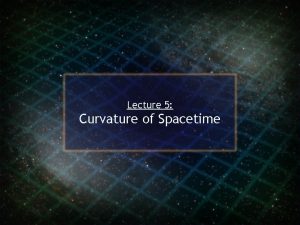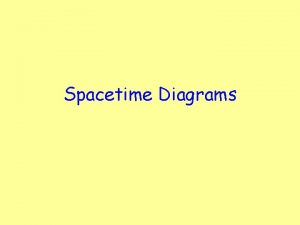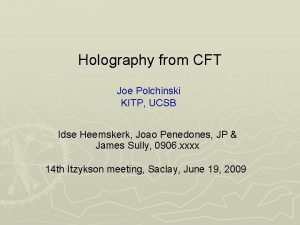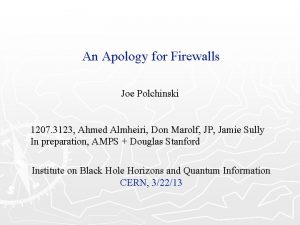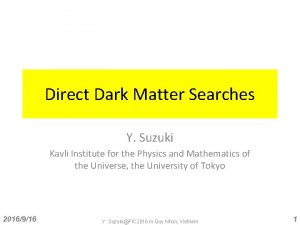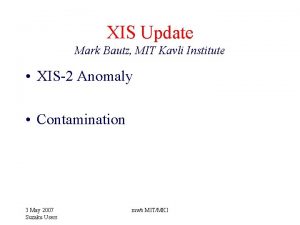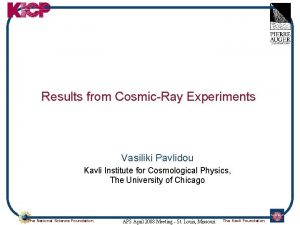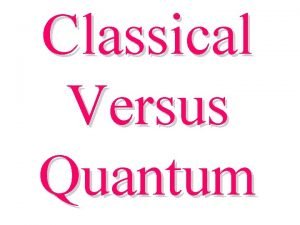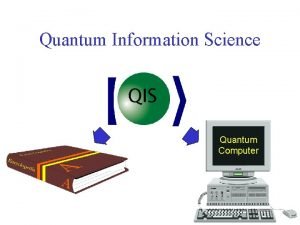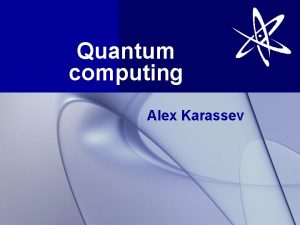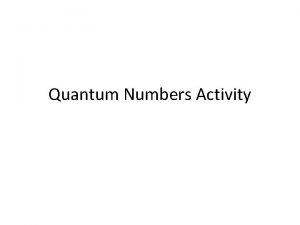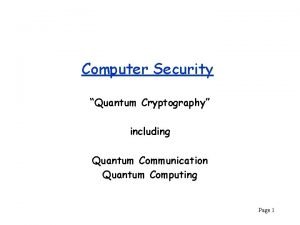Spacetime versus the Quantum Joseph Polchinski Kavli Institute

























































- Slides: 57

Spacetime versus the Quantum Joseph Polchinski Kavli Institute for Theoretical Physics University of California at Santa Barbara PITP, UBC Nov. 12, 2014

“God does not play dice with the world’’ (Albert Einstein, 1926) vs.

“God does not play dice with the world’’ (Albert Einstein, 1926) vs. “God not only plays dice, He sometimes throws the dice where they cannot be seen. ” (Stephen Hawking, 1976)

Three great revolution in physics: Special Relativity (1905) General Relativity (1915) Quantum Mechanics (~1925) The challenge still: to find a theory that unifies quantum mechanics and relativity Thought experiments have played a major role, and black holes have been an important arena for these.

James Clerk Maxwell’s thought experiment

The tee-shirt before Maxwell:

Before Maxwell: Gauss’s law: charges produce electric fields (1735) Faraday’s law: changing magnetic fields produce electric fields (1831) Ampere’s law: electric currents produce magnetic fields (1826) Earlier terms discovered experimentally

Maxwell’s simple thought experiment: x capacitor Experiment: put a capacitor in an alternating current. Measure the magnetic field at x. The incomplete set of equations gives two different answers. This can be fixed by adding one more term.

Before Maxwell:

After Maxwell (1861):

Adding Maxwell’s term fixed everything, and gave an unexpected bonus: Faraday Maxwell magnetic ® electric ®. . . = electromagnetic wave speed = 1/m 0 e 0 = speed of light (to few % accuracy)

Before Maxwell:

Lessons: • Why a thought experiment instead of a real one? In order to see the displacement term, one needed gigahertz frequencies, a billionth of a second. Hertz figured out how to do this, 25 years later. • Why was this thought experiment effective? The experimentalists had already done most of the work! They had found three terms, and Maxwell filled in the last.

In quantum gravity, we are in a similar situation: • In order to probe quantum gravity, we need to reach the giga-giga-gigahertz time scale: The Planck time √ h G/c-5 = 5. 4 x 10 -44 sec. • We already know a lot: the separate theories of quantum mechanics and general relativity are each highly successful and well-confirmed in their own regimes.

Back to the problem: Special Relativity: very fast General Relativity: very massive Quantum Mechanics: very small But what if something is both very fast and very small?

Quantum mechanics + special relativity Dirac started with Schrodinger’s equation: This describes quantum behavior of atoms, molecules, but fails for particles moving close to the speed of light. Dirac solved this by finding an improved equation:

Dirac’s equation agrees with Schrodinger’s equation for `slow’ things like atoms and molecules, but it correctly incorporates special relativity. The surprise: it has twice as many solutions as expected. The extra solutions represent antimatter, discovered by Anderson two years later. Unification often leads to unexpected discoveries: electricity + magnetism ® light QM + SR ® antimatter

The story of special relativity + quantum mechanics went on after Dirac: Quantum field theory The Standard Model (~1971). Predicted: gluon (discovered 1979) W boson (discovered 1983) Z boson (discovered 1983) top quark (discovered 1995) Higgs boson (discovered 2012) Special relativity + quantum mechanics fit together without conflict. General relativity will be much harder…

Quantum mechanics + general relativity What if something is both very massive and very small? GR is very successful on the cosmic scale QM is very successful on the atomic scale We have to go to extreme environments to find situations where both are important. One such environment is the early moments of the Big Bang. Another is the event horizon of a black hole.

Why are there galaxies, instead of a uniform gas? What determines the pattern: the sizes and numbers of galaxies, and their distribution?

Why are there galaxies, instead of a uniform gas? What determines the pattern: the sizes and numbers of galaxies, and their distribution? Quantum mechanics!

This quantum pattern is also seen in the Cosmic Microwave Background (CMB), radiation left from the early moments of the Big Bang.

The pattern in the galaxies, and in the CMB, formed in the first second after the Big Bang. But we want to push back even further in time, and our theories break down.

Thought experiments with black holes • The fate of very massive objects. horizon • An extreme bending of spacetime. • `Infinite’ density at the singularity • The horizon: the point of no return.

Confronting quantum mechanics with general relativity in a black hole leads to two conflicts: • The entropy puzzle (Bekenstein, Hawking, 1972 -4) • The information paradox (Hawking, 1976). Latest incarnation: the firewall.

Entropy puzzle: general relativity describes black holes as smooth geometries, without `hair. ’ Quantum mechanics points to an atomic or bit substructure. Evidence for the latter: • Information storage limit (Bekenstein) • The black hole temperature (Hawking, 1974). A further lesson: the holographic principle.

Bekenstein: calculate number of bits of information that a black hole can contain, as a function of its radius R. • Minimum energy to add one bit: hc/R • Total energy of a black hole of radius R: c 4 R/G. • # of bits = energy/(energy per bit) = c 3 R 2/h. G. Hawking: black holes radiate with a temperature k. T = hc/R. Total number of bits = energy/k. T = c 3 R 2/h. G. What are these bits?

The holographic principle: the Bekenstein-Hawking result for the number of bits in a black hole is interesting: - = R 2/l. Planck 2 c. R 2/h. G For most systems the number of bits is proportional to the volume, R 3. This suggests that the fundamental degrees of freedom of a gravitating system live on its surface: If so, this would be fundamentally different from any system that we are familiar with, a radical change in the nature of space.

Hawking radiation and black hole evaporation Quantum mechanics says that empty space is full of particle-antiparticle pairs that pop into and out of existence:

When this happens near the horizon, sometimes one falls into the singularity and one escapes: horizon singularity This carries energy away, and the black hole loses mass.

Without quantum mechanics, black holes always grow, but due to Hawking radiation they can `evaporate’ and eventually disappear:

Black hole evaporation is not controversial, but it leads to the information paradox, which is: evaporation destroys information about what falls into black holes. Quantum mechanics does not allow information to be destroyed. But for the information to get out, it would have to travel faster than light! Quantum mechanics versus relativity!

Hawking: “God not only plays dice, He sometimes throws the dice where they cannot be seen. ’’ Information lost: violates quantum mechanics Information escapes: violate relativity

How this was resolved: Many quantum systems have been found to have the surprising property of duality : two seemingly different systems that are actually the same (like waves and particles). When one description becomes highly quantum, the second becomes classical and simple. Maldacena (1997) found a duality between a quantum mechanical black hole and a much more ordinary system, a gas of strongly interacting particles (similar to the quarks and gluons of nuclear physics).

Ad. S/CFT duality: = Like Maxwell, an unexpected connection between widely different areas of physics. Before & after Ad. S/CFT ~ before & after the internet. The most complete construction of quantum gravity to date.

= Consequences: • Quarks + gluons obey ordinary QM: info can’t be lost. • Provides the bits predicted by Bekenstein and Hawking. • Holographic: the bits live on the surface.

So where do we stand? • The holographic principle is very different from previous physical laws. How does it work in detail? Especially, how does it work in an expanding spacetime? (Maldacena’s duality works in a special box, anti-de Sitter space - Ad. S). • The interior of a black hole is a lot like Big Bang (in reverse), so maybe this is a good place to start? • Where exactly did Hawking go wrong: how does the information get out? *

Things that were widely believed: • Information is not lost. • An observer who stays outside the black hole sees nothing unusual. • An observer who falls through the horizon sees nothing unusual. Black hole complementarity: information doesn’t actually travel faster than light. The outside observer sees it come out, the infalling observer sees it inside, and they can’t compare notes – a new relativity principle (‘t Hooft Susskind).

Things that were widely believed: • Information is not lost. • An observer who stays outside the black hole sees nothing unusual. • An observer who falls through the horizon sees nothing unusual. Actually these seem to be inconsistent! They imply an impossible quantum state for the Hawking radiation.

The argument is based on another mysterious property of quantum mechanics: entanglement.

The Hawking pair is produced in an entangled state, |0› + |1› Conservation of information requires that the Hawking photons be entangled with each other (a pure state). QM does not allow this, entanglement is monogamous! (|0› + |1›) |0› vs. |0› (|0› + |1›)

(|0› + |1›) |0› information loss vs. |0› (|0› + |1›) firewall! Sort of like breaking a chemical bond, losing the entanglement across the horizon implies a higher energy state.

If nothing unusual happens outside the horizon, and information is not lost, and infalling observer will hit a firewall of high energy particles: instead of Once again, a sharp conflict between quantum mechanics and spacetime…

After a year and >100 papers, there is no consensus. Most attempts to evade the firewall require loosening the rules of quantum mechanics: Strong complementarity (no global Hilbert space) Limits on quantum computation (Harlow & Hayden) Final state boundary condition at the black hole singularity (Horowitz & Maldacena; Preskill & Lloyd). EPR = ER (Spacetime from entanglement, Maldacena & Susskind). Nonlinear observables (Papadodimas & Raju, Verlinde 2). All of these are preliminary frameworks, not theories.

• Are there any observational effects for black holes? Some ideas would lead to this, but the argument is consistent with the exterior being exactly as in the usual picture, except perhaps for very subtle quantum effects. • Are there any consequences for the early universe? Too early to say. Are cosmological horizons like black hole horizons? Is there a version of the information problem? Most important, this may give us a new lever on applying holography to cosmology.

Conclusion: Thought experiments with black holes have led to some surprising discoveries: black hole bits, the holographic principle, Maldacena’s duality. The latest thought experiment presents new challenges, and we can hope that it will lead us to a more complete theory of quantum gravity.



The string-in-a-box thought experiment Strings were an unfamiliar idea, and many thought experiments have been useful in understanding their physics. Here is an important one: ? Put a string in a finite space Make the space smaller…and smaller The mathematics gets interesting, and leads to a surprising picture:

? = ! When the original space goes away, a new large space emerges (`T-duality’). Lessons: • Space is emergent, not fundamental. • There is a minimum distance.

That was for a closed string for an open string: . Now try it ? Put a string in a finite space Make the space smaller…and smaller Again, the trick is to figure out what is the physical picture that emerges from the math, and the answer is unexpected:

? = ! The emergent space also contains a new object, a `Dirichlet membrane, ’ or `D-brane’ for short. We do not know the full and final formulation of `string theory, ’ it is a work in progress. The strings were just a step toward the final answer, and the D-branes seem a little closer.

Planck units (1899): - G/c 5 = 5. 4 x 10 -44 sec. Planck time √ h - G/c 3 = 1. 6 x 10 -33 cm. Planck length √ h Each of Planck’s chosen constants was about to lead to a great revolution in physics: c: Special Relativity (1905) G: General Relativity (1915) h- : Quantum Mechanics (~1925)

• Particle collisions at extremely high energies, >> LHC. • The very early universe: the universe is expanding, and was once much smaller than it is today. • The cores, and horizons, of black holes.

Scattering at the giga 5 scale: . Planck energy . Applying the existing theories of QM + GR gives a nonsense answer, an infinite rate of scattering. A difficult problem, but it turns out that one can fix it if particles are not points but strings, Planck energy A strange idea, but it seems to work. Further thought experiments show that theory also need branes:

Scattering at the giga 5 scale: . Planck energy . Applying the existing theories of QM + GR gives a nonsense answer, an infinite rate of scattering. A difficult problem, but it turns out that one can fix it if particles are not points but strings, Planck energy A strange idea, but it seems to work. Further thought experiments show that theory also need branes:

The early moments of the Big Bang: There is already evidence that QM was important in the early universe. Quantum fluctuations, amplified by gravity, appear to be the origin of all the structure in the universe. These fluctuations originated slightly after the Planck time. For a complete account of the beginning of the universe, we need a unified theory of QM & GR.
 Kavli sedid
Kavli sedid De sitter spacetime
De sitter spacetime Spacetime coordinates review
Spacetime coordinates review Spacetime diagram examples
Spacetime diagram examples Spacetime walker
Spacetime walker Classical mechanics
Classical mechanics Quantum physics vs quantum mechanics
Quantum physics vs quantum mechanics Quantum edge healing institute
Quantum edge healing institute Trời xanh đây là của chúng ta thể thơ
Trời xanh đây là của chúng ta thể thơ Các số nguyên tố là gì
Các số nguyên tố là gì Tỉ lệ cơ thể trẻ em
Tỉ lệ cơ thể trẻ em Tia chieu sa te
Tia chieu sa te Các châu lục và đại dương trên thế giới
Các châu lục và đại dương trên thế giới Thế nào là hệ số cao nhất
Thế nào là hệ số cao nhất Hệ hô hấp
Hệ hô hấp ưu thế lai là gì
ưu thế lai là gì Tư thế ngồi viết
Tư thế ngồi viết Cái miệng xinh xinh thế chỉ nói điều hay thôi
Cái miệng xinh xinh thế chỉ nói điều hay thôi Hình ảnh bộ gõ cơ thể búng tay
Hình ảnh bộ gõ cơ thể búng tay đặc điểm cơ thể của người tối cổ
đặc điểm cơ thể của người tối cổ Mật thư tọa độ 5x5
Mật thư tọa độ 5x5 Tư thế ngồi viết
Tư thế ngồi viết Chó sói
Chó sói Thẻ vin
Thẻ vin Thơ thất ngôn tứ tuyệt đường luật
Thơ thất ngôn tứ tuyệt đường luật Các châu lục và đại dương trên thế giới
Các châu lục và đại dương trên thế giới Từ ngữ thể hiện lòng nhân hậu
Từ ngữ thể hiện lòng nhân hậu Diễn thế sinh thái là
Diễn thế sinh thái là Thế nào là giọng cùng tên? *
Thế nào là giọng cùng tên? * Vẽ hình chiếu vuông góc của vật thể sau
Vẽ hình chiếu vuông góc của vật thể sau Làm thế nào để 102-1=99
Làm thế nào để 102-1=99 Hươu thường đẻ mỗi lứa mấy con
Hươu thường đẻ mỗi lứa mấy con Lời thề hippocrates
Lời thề hippocrates Chụp phim tư thế worms-breton
Chụp phim tư thế worms-breton đại từ thay thế
đại từ thay thế Quá trình desamine hóa có thể tạo ra
Quá trình desamine hóa có thể tạo ra Cong thức tính động năng
Cong thức tính động năng Thế nào là mạng điện lắp đặt kiểu nổi
Thế nào là mạng điện lắp đặt kiểu nổi Dot
Dot Bổ thể
Bổ thể Vẽ hình chiếu đứng bằng cạnh của vật thể
Vẽ hình chiếu đứng bằng cạnh của vật thể Biện pháp chống mỏi cơ
Biện pháp chống mỏi cơ độ dài liên kết
độ dài liên kết Kể tên các môn thể thao
Kể tên các môn thể thao Khi nào hổ con có thể sống độc lập
Khi nào hổ con có thể sống độc lập Thiếu nhi thế giới liên hoan
Thiếu nhi thế giới liên hoan Hát lên người ơi alleluia
Hát lên người ơi alleluia điện thế nghỉ
điện thế nghỉ Một số thể thơ truyền thống
Một số thể thơ truyền thống Methods versus methodology
Methods versus methodology Religion and conflict theory
Religion and conflict theory Mandatory product adaptation
Mandatory product adaptation Content analysis system
Content analysis system Indulgence vs. restraint hofstede
Indulgence vs. restraint hofstede Tone of the writer
Tone of the writer Scary tones examples
Scary tones examples Indirect characterization paragraph example
Indirect characterization paragraph example

